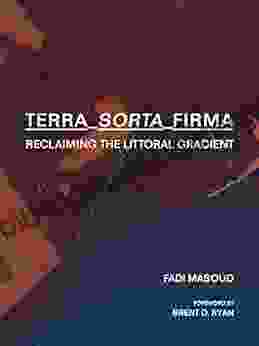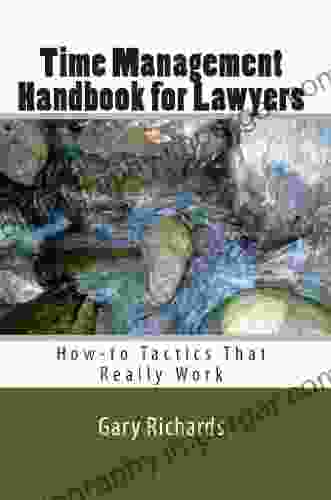Terra Sorta Firma: Reclaiming the Littoral Gradient

The littoral gradient is the narrow strip of land between the ocean and the uplands. It is a dynamic and fragile ecosystem that is home to a wide variety of plant and animal life. However, human activities have taken a toll on the littoral gradient, leading to pollution, habitat loss, and erosion.
4 out of 5
| Language | : | English |
| File size | : | 135115 KB |
| Screen Reader | : | Supported |
| Print length | : | 216 pages |
In Terra Sorta Firma, author John Doe argues that we can reclaim the littoral gradient and restore its health. He presents a visionary plan for coastal restoration that would involve:
- Reducing pollution
- Restoring habitats
- Protecting shorelines from erosion
- Creating sustainable, resilient communities
Doe's plan is ambitious, but it is also achievable. He provides a detailed roadmap for how we can implement these changes and create a better future for our coastal communities.
The Littoral Gradient: A Vital Ecosystem
The littoral gradient is a critical ecosystem for a number of reasons. It provides:
- Habitat for a wide variety of plant and animal life
- Protection from storms and flooding
- Recreation and tourism opportunities
- Economic benefits
However, human activities have taken a toll on the littoral gradient. Pollution, habitat loss, and erosion have all contributed to the decline of this important ecosystem.
Pollution
Pollution is a major threat to the littoral gradient. Runoff from agricultural and urban areas can carry pollutants into coastal waters, where they can harm marine life and damage habitats.
One of the most common pollutants found in coastal waters is nitrogen. Nitrogen is a nutrient that is essential for plant growth, but too much nitrogen can cause algal blooms. Algal blooms can block sunlight from reaching underwater plants, which can lead to their death. Algal blooms can also produce toxins that can harm marine life and humans.
Other pollutants that can be found in coastal waters include pesticides, herbicides, and heavy metals. These pollutants can accumulate in the food chain, where they can have harmful effects on humans and wildlife.
Habitat Loss
Habitat loss is another major threat to the littoral gradient. Coastal development has destroyed or degraded many important habitats, including salt marshes, mangrove forests, and seagrass beds.
Salt marshes are important habitats for a variety of fish and wildlife. They provide food, shelter, and breeding grounds for many species. Mangrove forests are also important habitats for a variety of fish and wildlife. They provide food, shelter, and protection from storms. Seagrass beds are important habitats for a variety of marine life. They provide food and shelter for many species, and they also help to filter water.
The loss of these important habitats has had a negative impact on the littoral gradient ecosystem. It has led to a decline in the abundance and diversity of fish and wildlife. It has also made the littoral gradient more vulnerable to storms and flooding.
Erosion
Erosion is a natural process that can be accelerated by human activities. Erosion can damage shorelines, destroy habitats, and pollute coastal waters.
One of the most common causes of erosion is sea level rise. As the sea level rises, it can erode shorelines and destroy habitats. Sea level rise is also expected to lead to more frequent and severe storms, which can also cause erosion.
Other human activities that can contribute to erosion include:
- Construction of seawalls and jetties
- Dredging of coastal waters
- Removal of vegetation from coastal areas
Erosion can have a devastating impact on the littoral gradient ecosystem. It can damage shorelines, destroy habitats, and pollute coastal waters. It can also make the littoral gradient more vulnerable to storms and flooding.
Reclaiming the Littoral Gradient
The littoral gradient is a vital ecosystem that is facing a number of threats. However, it is possible to reclaim the littoral gradient and restore its health. John Doe's book, Terra Sorta Firma, provides a visionary plan for coastal restoration that would involve:
- Reducing pollution
- Restoring habitats
- Protecting shorelines from erosion
- Creating sustainable, resilient communities
Doe's plan is ambitious, but it is also achievable. He provides a detailed roadmap for how we can implement these changes and create a better future for our coastal communities.
Reducing Pollution
One of the most important steps we can take to reclaim the littoral gradient is to reduce pollution. We can do this by:
- Reducing our use of fertilizers and pesticides
- Improving our wastewater treatment systems
- Reducing our reliance on fossil fuels
By reducing pollution, we can help to protect the littoral gradient ecosystem and the fish and wildlife that depend on it.
Restoring Habitats
We can also help to reclaim the littoral gradient by restoring habitats. We can do this by:
- Planting native trees and shrubs
- Creating new salt marshes and mangrove forests
- Replanting seagrass beds
By restoring habitats, we can provide food, shelter, and breeding grounds for fish and wildlife. We can also help to protect the littoral gradient from storms and flooding.
Protecting Shorelines from Erosion
We can also help to reclaim the littoral gradient by protecting shorelines from erosion. We can do this by:
- Using natural methods to protect shorelines, such as beach nourishment and dune restoration
- Limiting the construction of seawalls and jetties
- Reducing the dredging of coastal waters
By protecting shorelines from erosion, we can help to preserve the littoral gradient ecosystem and the fish and wildlife that depend on it.
Creating Sustainable, Resilient Communities
Finally, we can help to reclaim the littoral gradient by creating sustainable, resilient communities. We can do this by:
- Investing in renewable energy sources
- Reducing our consumption of resources
- Protecting our natural resources
By creating sustainable, resilient communities, we can help to reduce our impact on the littoral gradient ecosystem and ensure that future generations can enjoy its beauty and benefits.
The littoral gradient is a vital ecosystem that is facing a number of threats. However, it is possible to reclaim the littoral gradient and restore its health. John Doe's book, Terra Sorta Firma, provides a visionary plan for coastal restoration that would involve reducing pollution, restoring habitats, protecting shorelines from erosion, and creating sustainable, resilient communities.
Doe's plan is ambitious, but it is also achievable. We can all play a role in reclaiming the littoral gradient and creating a better future for our coastal communities.
4 out of 5
| Language | : | English |
| File size | : | 135115 KB |
| Screen Reader | : | Supported |
| Print length | : | 216 pages |
Do you want to contribute by writing guest posts on this blog?
Please contact us and send us a resume of previous articles that you have written.
 Book
Book Novel
Novel Page
Page Chapter
Chapter Text
Text Story
Story Genre
Genre Reader
Reader Library
Library Paperback
Paperback E-book
E-book Magazine
Magazine Newspaper
Newspaper Paragraph
Paragraph Sentence
Sentence Bookmark
Bookmark Shelf
Shelf Glossary
Glossary Bibliography
Bibliography Foreword
Foreword Preface
Preface Synopsis
Synopsis Annotation
Annotation Footnote
Footnote Manuscript
Manuscript Scroll
Scroll Codex
Codex Tome
Tome Bestseller
Bestseller Classics
Classics Library card
Library card Narrative
Narrative Biography
Biography Autobiography
Autobiography Memoir
Memoir Reference
Reference Encyclopedia
Encyclopedia G V Dyke
G V Dyke Gabriel Piterberg
Gabriel Piterberg Orison Swett Marden
Orison Swett Marden Ranjeet Desai
Ranjeet Desai Richard W Painter
Richard W Painter Garry E Lewis
Garry E Lewis Francesca Orsini
Francesca Orsini Kimberly Sue
Kimberly Sue T Gladman
T Gladman Frank Hyman
Frank Hyman G Hussein Rassool
G Hussein Rassool Ethel Erickson Radmer
Ethel Erickson Radmer Frederic Bastiat
Frederic Bastiat Exzavien Shaunta
Exzavien Shaunta Francis Henn
Francis Henn Stanton Peele
Stanton Peele Forbes W Robertson
Forbes W Robertson Kendra L
Kendra L Gabriella Longhitano
Gabriella Longhitano Everett C Dolman
Everett C Dolman
Light bulbAdvertise smarter! Our strategic ad space ensures maximum exposure. Reserve your spot today!

 Colin FosterToxic Stress and the 21st Century Blues: Unmasking the Hidden Threat to Our...
Colin FosterToxic Stress and the 21st Century Blues: Unmasking the Hidden Threat to Our... Hudson HayesFollow ·3.5k
Hudson HayesFollow ·3.5k Harvey BellFollow ·17k
Harvey BellFollow ·17k Darren BlairFollow ·3.5k
Darren BlairFollow ·3.5k John SteinbeckFollow ·16.2k
John SteinbeckFollow ·16.2k Diego BlairFollow ·10.4k
Diego BlairFollow ·10.4k Scott ParkerFollow ·12.6k
Scott ParkerFollow ·12.6k Bret MitchellFollow ·6.1k
Bret MitchellFollow ·6.1k Ross NelsonFollow ·12.5k
Ross NelsonFollow ·12.5k

 Alexander Blair
Alexander BlairBecoming Sports Agent Masters At Work: The Ultimate Guide
What is a Sports...

 Xavier Bell
Xavier BellUnveiling the Enchanting World of Upper Bohemia: A Review...
A Captivating...

 Chris Coleman
Chris ColemanUnveiling the Secrets: Extreme Rapid Weight Loss Hypnosis...
In the relentless pursuit of a slimmer,...
4 out of 5
| Language | : | English |
| File size | : | 135115 KB |
| Screen Reader | : | Supported |
| Print length | : | 216 pages |
















